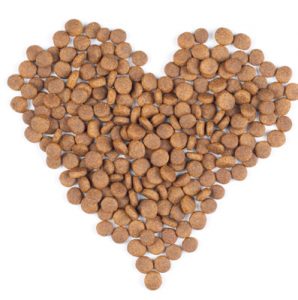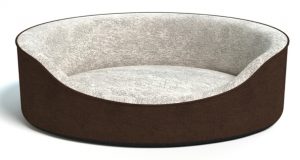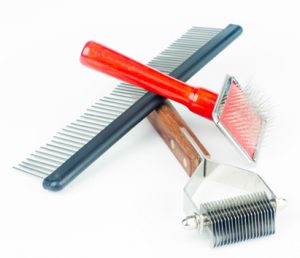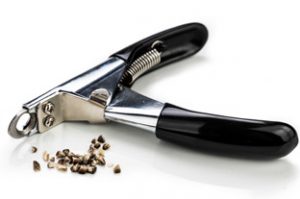Published Spring 2017
Written by Tiffany Cannon
We have 7 dogs in the house right now ranging in ages from 7 months to 10 ½ years. It’s obvious that they have different energy levels but they have different needs on a lot of different levels. As hard as it is to believe, dogs are considered senior somewhere between 7 and 10 years old. Vigilance and close observation will help you know when it’s time to make some changes to keep your best friend as comfortable as possible.
Diet
 Older dogs might have different dietary needs than they did when they were young. If they are particularly sedentary, eating the same food in the same quantity could lead to excessive weight gain. There are several foods formulated specifically for older dogs – some contain supplements that help manage joint health and provide necessary vitamins and minerals. But other foods advertised as ‘for seniors’ might be more marketing ploy than anything else. Consult your veterinarian to help you determine what food might be best suited to your dog’s dietary needs. Your vet might also suggest a supplement containing chondroitin or glucosamine. Finally, older dogs can develop sensitive stomach even when they previously had no problems at all. If you have always fed your dog once per day, it might be necessary to feed your old guy two or three times a day in smaller meals to help ease digestion issues.
Older dogs might have different dietary needs than they did when they were young. If they are particularly sedentary, eating the same food in the same quantity could lead to excessive weight gain. There are several foods formulated specifically for older dogs – some contain supplements that help manage joint health and provide necessary vitamins and minerals. But other foods advertised as ‘for seniors’ might be more marketing ploy than anything else. Consult your veterinarian to help you determine what food might be best suited to your dog’s dietary needs. Your vet might also suggest a supplement containing chondroitin or glucosamine. Finally, older dogs can develop sensitive stomach even when they previously had no problems at all. If you have always fed your dog once per day, it might be necessary to feed your old guy two or three times a day in smaller meals to help ease digestion issues.
Most people agree that table scraps aren’t good for your dog, but they can be even more dangerous for an older dog. Rich, fatty foods can cause all kinds of digestive issues including pancreatitis. Stick to low fat, dog-appropriate treats.
Soft Bedding
 I remember as a teenager when I loved laying on the floor. My brothers and I would play board games at night, lying on our stomachs in the living room, propped up on our elbows playing Monopoly or Battleship. If I tried to lay that way now for any length of time, my back would really start expressing its disapproval! My joints just aren’t what they used to be. Thirty years has taken a toll. I get up more slowly in the morning, stretch a bit to get the blood flowing and definitely prefer a softer bed to keep my back and hips comfortable at night. It’s important to provide soft padded bedding for your older dog too. They’ll sleep more comfortably but hopefully, you will too. Dogs that have comfortable bedding won’t tend to wander as much at night, they don’t need to reposition themselves as often to alleviate pain, they stay asleep and are more rested in the morning. Our old guys deserve comfort.
I remember as a teenager when I loved laying on the floor. My brothers and I would play board games at night, lying on our stomachs in the living room, propped up on our elbows playing Monopoly or Battleship. If I tried to lay that way now for any length of time, my back would really start expressing its disapproval! My joints just aren’t what they used to be. Thirty years has taken a toll. I get up more slowly in the morning, stretch a bit to get the blood flowing and definitely prefer a softer bed to keep my back and hips comfortable at night. It’s important to provide soft padded bedding for your older dog too. They’ll sleep more comfortably but hopefully, you will too. Dogs that have comfortable bedding won’t tend to wander as much at night, they don’t need to reposition themselves as often to alleviate pain, they stay asleep and are more rested in the morning. Our old guys deserve comfort.
Home Accessibility
Stairs, jumping on beds and on furniture etc. can begin to present challenges they did not in earlier years. Observing your dog’s movement through the house can sometimes provide your first glimpse into aging behavior.
Older dogs (like older people) have less padding in those joints than they used to. This fact can have a lot of implications for you and your home. Our dogs love to hop up on the couch and lounge there during the day. Our older dogs can still hop up most of the time, but will be hesitant about hopping down. We don’t have any carpet in the den where the dogs stay during the day and it is obviously painful at times when they jump down from the couch to the tile floor. If my oldest girl Truffle sees me in the room, she will move back and forth until I come over and give her a “puppy elevator” ride to the ground.
I think I prefer having a girl who ‘sort of’ knows her limits though to one that still thinks he’s a puppy and tries to jump off the bed or the back of the couch. Older dogs are definitely more susceptible to injuries. If we leave really comfortable beds on the ground, our older girls tend to prefer sleeping on the ground level beds rather than jump on the couch. We have also needed to change up the types of beds we leave on the floor for the dogs. Our dogs have always loved having beds with walls – something they can nestle into and where they can have a built in pillow. We also have raised beds our dogs absolutely love. But arthritis has afflicted our oldest and at the end of an active day, she has trouble throwing her leg up over the wall. Putting down some flat Temper-Pedic-style beds has allowed the dogs to have options to fit their different daily comfort needs.
Slippery floors can be tough for older dogs to navigate as they begin to experience stiffness. If you have tile or hard wood floors, you might consider adding area rugs or runners in areas frequently navigated by your older dog. If you have slippery floors, you need to be especially vigilant with keeping toe nails trimmed as long toe nails exacerbate any traction issues your dog might already be having.
As your dog continues to age, eyesight changes are also common. Dogs who know the layout of their homes well can hide eyesight issues for a long time. If you move any furniture, watch your dog carefully the first few days to see if they are having any difficulties navigating the new configuration in their living space. While normal as part of the aging process, changes in eyesight should be discussed with your vet. Eyesight changes can lead your pup to experience more fear and timidity, especially in unfamiliar places.
Home accessibility is imperative because older dogs can be injured much more easily than flexible, muscular, active young dogs. Slips on the floor or an awkward landing coming off the couch can lead to painful leg and back injuries.
Another place where injuries can easily occur are in the car. Jumping in and out of the car can be even more awkward that jumping off items in the house. It’s also best to buckle up your dog while traveling by car of have him in a crate. We’ve all experienced the sudden stopping situation in traffic where our dog flies forward onto the floor board. This could be very dangerous for our older companions.
Exercise
Your older Peeb has most likely slowed down a bit, but will still need and appreciate regular exercise. Moderation is key, but exercise will help keep your dog’s appetite stimulated, will help keep muscles and bones strong and gives your dog something to look forward to. Most older dogs will be more appreciative of time to sniff instead of straining at the end of the leash. If you do have an old speed demon, it’s important that you control the tempo. Don’t let your older dog go too fast or too slow. They can overdo it easily in their enthusiasm.
Temperature Control
 Dogs become more sensitive to temperature swings as they age. They will appreciate a warm, dry place to snuggle up when the temperature plummets in the winter and might find it more difficult to stay cool in the summer. Older dogs (like older people have a more difficult time regulating their temperature).
Dogs become more sensitive to temperature swings as they age. They will appreciate a warm, dry place to snuggle up when the temperature plummets in the winter and might find it more difficult to stay cool in the summer. Older dogs (like older people have a more difficult time regulating their temperature).
Grooming
Keep it simple and quick! Sacrilegious as it may be, I shave my two oldest girls. They hate being on the grooming table. They hate being brushed, combed, detangled, and having their toe nails trimmed. My oldest has always hated being groomed and has battled me from day one. It’s no surprise that she despises it even more now that she has arthritis. Cricket was a dream on the table as a young dog. But over the last couple of years, she has started fussing anytime we hit a tiny mat that needs to be pulled. Has she become more sensitive to pain in her advanced years or simply less tolerant? No way to know for sure, but she’s given us three litters and 18 babies. If she doesn’t want to be groomed any longer…she won’t be.
 However you do your grooming, it remains a very important activity for your aging dog. Grooming provides private time when you can assess the general health of your old friend. This is your opportunity to check for unexpected wear and tear, find signs of a problem before it advances too far and become familiar with the stages of aging so you will be able to recognize changes when they are occurring.
However you do your grooming, it remains a very important activity for your aging dog. Grooming provides private time when you can assess the general health of your old friend. This is your opportunity to check for unexpected wear and tear, find signs of a problem before it advances too far and become familiar with the stages of aging so you will be able to recognize changes when they are occurring.
Brush teeth every month to check for signs of decay. Watch for signs that your dog’s mouth is beginning to be painful. If your older dog stops wanting to eat kibble or crunchy treats but will eat soft food, there might be a problem with his mouth or teeth. Give your dog things to chew on such as Greenies, Hooves, Antlers and Bully Sticks which will help naturally keep plaque and tartar from building up. Consider having your dog’s teeth professionally cleaned at the vet when possible. This usually involves anesthesia so it’s important to discuss with your vet whether or not your dog is healthy enough for the procedure.
 Trim Toe nails more frequently… Your older dogs aren’t running around like they used to. It seems like our dogs toe nails grow faster in older age…but the simple fact is that our veterans aren’t moving around as much. They don’t cover as much distance, they don’t move as quickly and they aren’t choosing to travel over the same rough terrain they did as youngsters. They are simply no longer being exposed to or experiencing the same surfaces and outdoor settings that naturally served to file down the nails as youngsters. If you take your dog for walks every day and walk your dog on cement, you will not need to trim toe nails as often as someone whose dogs get all their exercise in the back yard.
Trim Toe nails more frequently… Your older dogs aren’t running around like they used to. It seems like our dogs toe nails grow faster in older age…but the simple fact is that our veterans aren’t moving around as much. They don’t cover as much distance, they don’t move as quickly and they aren’t choosing to travel over the same rough terrain they did as youngsters. They are simply no longer being exposed to or experiencing the same surfaces and outdoor settings that naturally served to file down the nails as youngsters. If you take your dog for walks every day and walk your dog on cement, you will not need to trim toe nails as often as someone whose dogs get all their exercise in the back yard.
Lumps and Bumps
Older dogs sprout all manner of lumps and bumps. Most are harmless and have no medical relevance. But it’s a good idea to investigate if you find that a new lump or bump has popped up in a new place. Skin tags, fatty tumors and cysts can seemingly grow overnight. But these can closely resemble cancerous growth and it’s a good idea for you to regularly check for changes in your dog’s skin. Your vet may want to perform a needle aspiration to determine if the lump is harmless or of concern. If you groom your dog at least once a month, you will have a good baseline of your dog’s “normal” state and will know when something out of the ordinary pops up. Be sure to remember to check in ears, mouth, in between toes and around private parts every time you groom.
Vet Care
If you have always gone to the vet only for an annual checkup, it might be a good idea to switch to a bi-annual visit. Ask your vet if a blood test is recommended. Kidney, liver and many other health issues might be detected at early onset when they will still respond to treatment. With your aging dog, the goal of a vet visit shouldn’t just be about treatment but prevention as well. It’s also important to act quickly when you do notice any issues to allow you to maximize treatment options.
Be Patient
Patience is a virtue and our older dogs will try our patience at times. But it is imperative that we have patience and demonstrate understanding to our old friends. In their advanced years, dogs slow down and take longer to comply with our requests to come. In fact, whether it is from discomfort or simply willfulness, they may ignore you altogether. Our 9 ½ year old Cricket was the only PBGV in my house who actually listened to me reliably and would come when called. Not anymore! She has decided she likes being in the front room where the other dogs aren’t allowed to be except when we are feeding. She stays in the kitchen and stares at the food container in the utility room or she will nestle down in the laundry pile in front of the washing machine. At night, when it’s time for bed, she will now only come willingly when bribed with an appropriate treat. She will not come for a milk bone…leaving her front room requires a piece of chicken or cheese. Any attempt to persuade her by calling is ignored and if you raise your voice to her, she slinks into kitchen and crawls into a crate. Older dogs have a tendency to operate completely on their own agenda.
Other age related issues we have to deal with are problems that are physical in nature. For Truffle, if I am trying to get her attention, I need to waive my arms and not just call her name. She can’t see far away any longer, but she can still pick up movement quite easily. Luckily, we haven’t had to worry about incontinence yet, but it is also a realistic issue that is completely out of our old dog’s control. If your older dog is starting to have accidents in the house, your vet might have something that will help and you will need to go out with your dog more frequently.
Fear Factors
You may notice your old friend is suddenly developing fears of things that never were a concern before. Our old ladies have suddenly developed a fear of thunder. Not unusual for a PBGV…but not normal for my crew. Noise sensitivity is particularly common as a cause for fear and concern. Ironic since this probably develops simultaneous to the beginning of hearing loss. Maybe there’s a connection?
With advanced age seems to develop an awareness that there are things in the world that can be scary and not in our dog’s realm of control. They seem quite aware of the fact that they are not physically up to meet a lot of the potential challenges they could face confidently as youngsters. With this realization, they look to their owners to give them that sense of security. It’s up to us to make our elders feel safe and protected. This might come in the form of a thunder shirt, or a crate kept in a quiet place where the old dog can hide in a safe place if they feel the need.
It is also common for older dogs to develop separation anxiety.
Privacy & Socialization
Socialization is important for older dogs but so is Privacy! A safe, private area where they can retreat and feel completely confident that they are safe and secure is a must for aging dogs who live in a bustling household. Older dogs need the ability to get away from young and crazy pack members (including other dogs and young children). Place a crate against a wall or in a corner of a quiet room. The top and sides of the crate should be covered with the front door left open. Provide soft bedding for the dog to use for nesting material and make sure the older dog has access to the room throughout the day. We use sheets or towels so our girls can fluff the bedding to their hearts content. If they try to fluff a crate pad, they can inadvertently end up trapped underneath it.
Socialization can also be important. Don’t assume just because your dog wants to observe the action instead of participating that they don’t need socialization at all. It’s good for your elder to meet new dogs and people. This helps to keep them feeling confident and comfortable in new environments.
Training
Spend time teaching your old dog new tricks. They love to learn new things and love to have the personal attention they get when you are spending time teaching them. Be realistic about the types of tricks you want to teach your old dog and limit the tricks to those that don’t involve difficult physical maneuvers. Limit the time devoted to each session so your dog doesn’t tire out or become frustrated. Then spend time doing what they want – sit on the couch, snuggle and take rides in the car or slow walks allowing them plenty of time to sniff.
Feeling the effects of age is an inevitable part of every life well lived. With some planning and preparation, our older dogs can enjoy life well into their middle age and the senior years.
Resources
“10 Ways to Make Your Old Dog Comfortable” by Cynthia Foley, Whole Dog Journal, April 2015
“9 Ways to Make Your Senior Dog’s Life Better” by Lori Taylor, I Love Dogs, November 17, 2015
“6 Ways to Comfort Your Senior Dog” by Lisa Spector, Care 2, May 27, 2015
“Old Dogs, New Habits: Ways to Make Senior Dogs More Comfortable” by Gina Spadafori, vetStreet.com, July 5, 2011
Leave A Comment